Bill C-16 was introduced this past Tuesday. The bill is officially known as “An Act to amend the Canadian Human Rights Act and the Criminal Code” and is to include gender identity and gender expression as grounds for explicit protection.
The contents of the bill is almost identical to the failed Bill C-279 of the last parliamentary session, and to the failed Bill C-389 before that. I talked about C-279 here, here, and here. I mentioned C-389 here. All in all, it’s been eleven years since bills like this have been introduced to Parliament.
It’s Different This Time
There are two notable differences about the introduction this time, however. First, this is a government bill. Previous efforts were private members bills brought forth by (now former) NDP MP Bill Siksay and then NDP MP Randall Garrison.
The second notable difference is the nature of the opposition.
A year ago the Conservatives held a majority government. Conservative MPs in the House of Commons were near unanimous in their votes against C-279. Internal documents indicated that the government opposed the bill. The four other parties unanimously supported the bill. MPs belonging to the governing party repeatedly vilified transgender women specifically, suggesting that recognizing their rights to use gendered facilities was to permit sexual predators to prey on children.
Whether or not it is called “the bathroom bill,” it allows for pedophiles to take advantage of legislation that we have in place.
In the Senate, the former president of the Conservative Party drummed up the same bigoted characterization and amended the bill as to explicitly legalize discrimination. Then the 2015 election came killing all unpassed bills including this one. I wrote a blog entry covering the legislation’s demise titled “When The Bigots Won.”
Fast-forward to today, and interim Conservative party leader Rona Ambrose indicated she would vote in support of Bill C-16 despite her previous opposition to C-279.
“I’ll be supporting it,” Ambrose told reporters on Tuesday. “While I know that in the past the courts have ruled that all of those protections do exist in the law, I do think the specific recognition and the codification in law is important. I know that it means a lot.”
Tony Clement, another senior Conservative politician, also reversed his stance to support the legislation. There are other stories of Conservative politicians coming out in support of the bill despite past voting record.
Meanwhile, Don Plett, the Conservative senator who amended C-279 as to make discrimination on the basis of gender identity and expression explicitly legal stated that his views hadn’t changed.
“You know my feeling on transgender rights. They haven’t changed since the last time I spoke about it,” said Plett, barely breaking stride on his way to enter the Senate.
But he also gave himself an out to potentially let the bill through.
“But because it’s now government legislation, obviously a lot of the rules have changed. So, I will make a decision in the coming weeks.”
Given the defeat of the Conservatives in 2015, given that the interim party leader and senior members support the measure, I can’t see the former president of the party undermine efforts by House conservatives to appeal to more people in Canada.
I’m fully confident that this bill will pass.
Very Short History of C-16
Trudeau seems to have been aware and in support of trans issues previous to the election. The party he was leading supported C-279 unanimously. He seemed to understand gender identity as a concept. Speaking of a new rule in 2012 that made air travel more precarious, he stated:
Mr. Speaker, since the election, this government’s lack of tolerance for our minorities has grown. A new rule prohibits airlines from allowing a person to board a plane if their appearance does not match the gender on their identification, unless they have a medical certificate. This is a direct affront to the transsexual and transgendered community, which is outraged by this minister who has introduced discrimination under the guise of security.
It should be noted the said rule was removed as soon as the Liberals took power, to little fanfare. Back to C-16, the first official mention of such a law came ten days after the 42nd Parliament began.
On Nov 14, 2015, the government took the exceptional step of publicly releasing Trudeau’s ministerial mandate letters, in which the prime minister assigns each minister with his priorities.
In his letter to Justice Minister Jody Wilson-Raybould, Trudeau listed 15 wide-ranging priorities, the last of which includes “legislation to add gender identity as a prohibited ground for discrimination” under both Canada’s human-rights and hate-speech provisions, which make it a criminal offence to discriminate against listed minorities.
At the time, however, there wasn’t a sense among activists of when Liberals would introduce such legislation. A month later, on December 9th, Randall Garrison brought forth Bill C-204.
Bill C-204 was named “An Act to amend the Canadian Human Rights Act and the Criminal Code (gender identity and gender expression)” and was a copy of C-279 from before the Conservatives stripped protections. Amanda Ryan explained the Bill C-204’s introduction as a means to pressure the government:
Ryan says Garrison is introducing this bill knowing that the Liberal government has promised to present their own trans rights bill, which would take priority over Garrison’s.
“His intention is to keep pressure on the government so their bill does not slip down the priority list,” she said.
Things were then silent on the public front. In April 2016, MPs started to disclose in private that the Liberal bill would be introduced this spring and passed later this year.
Last Sunday (May 15, 2016), word came there would be an announcement on Tuesday (May 17) to coincide with the International Day Against Homophobia and Transphobia. The wording of the bill wasn’t yet known, though it was expected to be another iteration of C-279.
On Tuesday, the news came with an official announcement at 10:15 aired on CPAC and a technical briefing at 10:45.
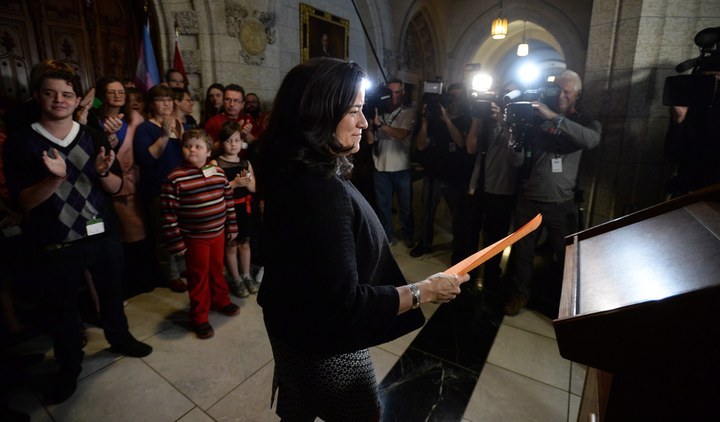
That meeting confirmed that the bill, now known to be C-16, mirrored the clauses in C-279.
Media Reaction
Reaction was prompt, and perhaps signalling a significant change from the environment in which C-279 was introduced, received significant national and international coverage.
In another change of significance, all of this coverage from major news outlets were worded in such a way to suggest bias in support of the legislation, with words such as “safeguard”, “protect” and “rights” in their headlines.
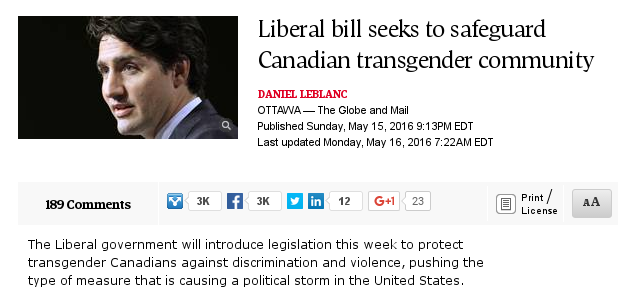
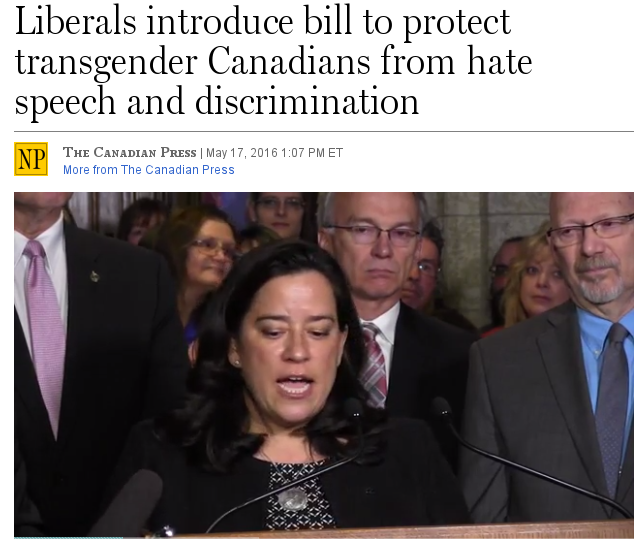
Compare that with C-279’s or C-389’s coverage, where journalists used words like “controversial” and the reductive “proposal.” Where journalists propagated the harmful and debunked myth of sexual predators in washrooms by adopting the “bathroom bill” moniker themselves. Where they gave equal weight to the voice of bigots not recognizing the false equivalence.
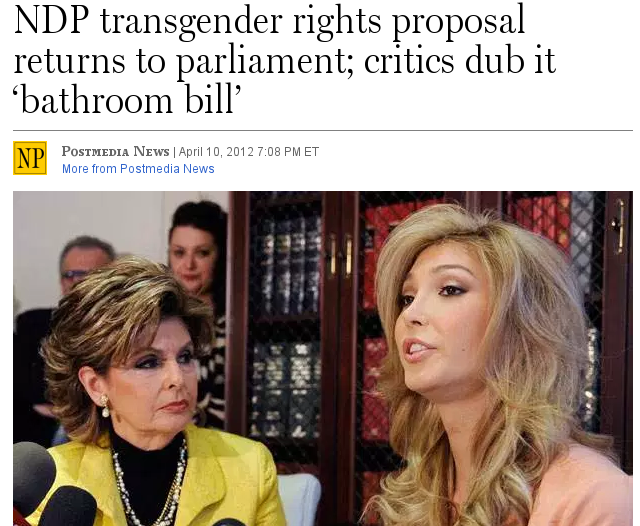
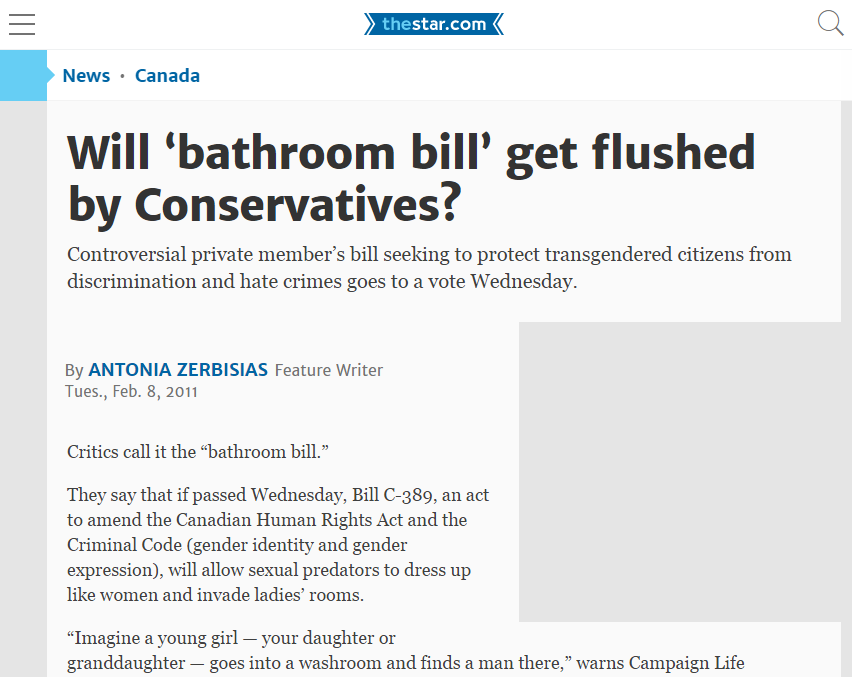
The tone of coverage completely changed in the media especially towards the end of C-279’s run. The support remains uneven, however. Both of the two national newspapers in Canada continue to release editorials opposing acceptance of trans people with headlines such as “Transgendered advocacy has gone too far” and “Kids pay the price of transgender politics.”
There was something else to be noted in the media attention. This misconception that the bill would change the situation for trans people. Radio Canada framed C-16 as “legislation to guarantee the rights of transgender people across the country” and “ban discrimination against transgender people.”
This simply isn’t true.
What the Bill Does
The bill amends the Canadian Human Rights Act and Criminal Code to include gender identity and expression. As it’s now categorized as a hate crime, police forces will start collecting data on violence on the basis of gender identity or expression. Those discriminated against will have a new avenue of recourse.
What the Bill Doesn’t Do
The bill doesn’t address any of the reasons people are marginalized on the basis of gender identity or expression. It doesn’t change any government policy. It’s wholly reactive, not pro-active.
Absent of any further government action, it leaves the burden of change to those who have the fewest resources to bring it about. Half of trans people in Ontario make less than $15,000 a year.
As for police taking metrics, 20% of trans people have been physically or sexually assaulted for being trans in Ontario while another 34% had been verbally threatened or harassed but not assaulted. Many do not report these assaults to the police. Hardly surprising when 24% reported having been harassed by police. Meanwhile half of homeless youth in Ottawa are LGBTQ, sex work is still effectively illegal in Canada, HIV is effectively criminalized, all issues that are disproportionally relevant to this demographic and to which the police act as agents that remove opportunities for safety and income. The police further enforce existing prejudice by assisting businesses who kick out trans patrons over gender ID matters through affirmations of private property. In this climate, the police stats collecting isn’t very meaningful.
The kind of discrimination that makes people unsafe, whether it’s a doctor refusing to care for the person because they’re trans, or a psychologist with questioning clients that believes trans people can’t be gay, or schools that dead name students, or a movie where dating a woman who is trans is the joke, or a workplace that requires gendered dress codes, or newspapers with editorials that defend reparative therapy and advocate against acceptance of youth, or street harassment, or what have you – these are all firmly left unchallenged in this new regime. After all, these examples I’ve just cited already exist in an environment where such legislation is already on the books. Ontario introduced gender identity and gender expression to its human rights code in 2012. All the perpetrators I’ve cited in these examples are safe from any legal action on grounds of discrimination.
And so I object to assertions that this law will make things safe. It won’t. It’s symbolic, to some extent it’s necessary, but it won’t change discrimination. At least not unto itself.
What It Takes To Bring Change
What it takes is what’s already taken place. Decades of work by an army of people, each building upon the shoulders of those before them, each doing something – however seemingly microscopic to them – to change what they can.
While these issues may seem to have exploded into popular consciousness, it will take decades more by all these people doing these changes to take down these social barriers.
There’s no easy fix.
Except oh maybe $15 minimum wage, actually making sex work legal, decriminalizing HIV, to start.
In The End
I was really disappointed when the bill was announced, I really hoped that the Liberals would have produced a more audacious piece of legislation given their majority and support by the opposition – even without Conservatives.
That wording for the bill, which dates back eleven years, was significant when it was introduced for the environment it was introduced in. Had it passed then, it would of had a real impact on attitudes towards acceptance of those who aren’t cisgender.
Now, however, with the public moving towards that acceptance, this symbolism is getting less and less impactful. Meanwhile, discrimination remains pervasive and easily defensible. I hope we’ll see policy changes in the future to help with that.
Despite my reservations, this is a victory. I am enormously thankful to all those who made it possible.

